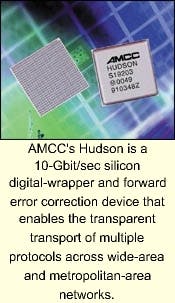New digital-wrapper device enables transparent transport
Meghan Fuller
Today's networks are undergoing a rapid transition into higher-speed SONET, jumping from OC-3 to OC-12 and into OC-48, which is currently the speed of most networks' backplanes. Now that the optics for OC-192 are entering maturity, the OC-192 market should also see increased deployments, says Jeremey Donovan, principle analyst at Gartner Dataquest (San Jose, CA). The migration to OC-192 is made possible by two key factors, he says, the first being the maturity of OC-192 components, already achieved by the likes of Nortel Networks and other key suppliers. The second factor, the development of a SONET framer and overhead processing device, has arrived in the form of the Hudson, a 10-Gbit/sec, digital-wrapper framer/ deframer and performance-monitoring device from Applied Micro Circuits Corp. (AMCC-San Diego).Its SONET/SDH performance-monitoring capabilities enable Hudson to support the existing infrastructure, but its real strength resides in its digital-wrapping capabilities, asserts Ken Prentiss, AMCC's director of marketing for telecommunications products. First developed by Lucent Technologies in early 1999, the digital wrapper utilizes a SONET-type structure but does not carry with it the additional overhead bytes associated with SONET when it is multiplexed to higher rates. SONET transport is based on subframes, each of which carries its own information in overhead bytes.
"The only information that's really required is, 'What is the destination of the entire frame-the 10-Gbit or OC-192 payload?'" explains Prentiss. "All you really need to know is, 'Where is this going?' but in SONET, you have overheard bytes for each of those subframes. You have 192 pieces of useless information."
AMCC's Hudson eliminates the need for transporting unnecessary and therefore costly overhead bytes by digitally wrapping the entire OC-192 payload, which can carry any traffic, including Ethernet, Fibre Channel, Frame Relay, and Gigabit Ethernet. That is one way in which the Hudson prepares for the future. Customers like the scalability, says Prentiss. "There's no protocol that could come along tomorrow that would make it obsolete."
Also built into the Hudson device is a forward error correction (FEC) code, which sends extra bits down the fiber to verify the integrity of the signal. "The price paid for that is that you do have to send extra information," admits Prentiss, "but the benefit is that you can actually transport [information] at longer distances with the same amplification, because your integrity is better. At 10 Gbits/sec, you can actually use the same application schemes that are in place for OC-48," he explains. The Hudson, therefore, eliminates the high cost of additional amplifiers at the 10-Gbit level, an advantage that has already made it popular among AMCC's customers, says Prentiss.
The Hudson also features automatic protection switching support. Like any SONET link transported through a carrier's network, the Hudson has built-in redundancy to preserve transmission despite a breakage in the line.
"There are actually two identical paths that are being transported," says Prentiss, "and if anything happens to one of them, the other would kick in automatically. The two Hudsons talk to each other, and they know when there is a break in the line. [Traffic] automatically switches to the other line in the less than 5-msec timeframe required to not have any interrupt in service."
Equally applicable in the wide-area and metropolitan-area network, the Hudson has over 20 different applications, says Prentiss. It performs frame and byte alignment, is full-duplex, and features enhanced scrambling and a bypass mode, which is used to bypass the FEC. The Hudson interfaces directly with AMCC's serializer/deserializer devices, the S3091/92 multiplexer and demultiplexer, which are used to slow down the 10-Gbit signal coming into the Hudson. It is also compatible with the company's OC-192 Framers, the Indus and Ganges.
Despite its wide range of applications, the Hudson faces some stiff competition. It's merchant silicon versus internal design, according to Donovan. "I would say that the significant OEMs either have in development or have already developed somewhat similar types of technologies to what AMCC has developed," he says. However, he admits that it might be easier for these OEMs to buy a merchant silicon solution. There are other potential benefits, as well.
"There's a couple of nice features that AMCC has included in the Hudson that are really addressing the needs of the OEMs they are selling to, but also address the needs of the carriers that the system OEMs are ultimately selling to," he asserts. "This chip, in a sense, not only supports traditional SONET but can also support 10-Gigabit Ethernet, for example. So it can serve those two markets separately, but it can also bridge the SONET world to the Ethernet world, which is a pretty compelling need amongst carriers today," he adds.
AMCC's Prentiss isn't concerned that custom ASICs will steal Hudson's spotlight. "One of the reasons why there is such a demand for our devices is because we take away the need to spend 12 to 18 months designing an intense ASIC like this," he explains. "We can sell it to a number of different vendors, who can then focus their time getting their boxes up and running."

